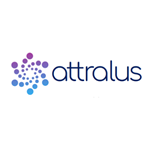Attralus, Inc. announced encouraging new clinical data from the University of Tennessee Graduate School of Medicine from its Phase 1/2 trial of iodine evuzamitide, the company’s pan-amyloid binding peptide in development as a radiotracer for the diagnosis of systemic amyloidosis.
- AT-01 is a first-in-class pan-amyloid imaging agent capable of detecting diverse types of amyloid
- Sensitivity in those with previously diagnosed cardiac disease was 100% in ATTR and 93% in AL
- Cardiac uptake was also observed in eleven patients who had not previously been diagnosed with cardiac disease
SAN FRANCISCO, April 04, 2022 (GLOBE NEWSWIRE) -- Attralus, Inc., a clinical stage biopharmaceutical company developing transformative medicines to improve the lives of patients with systemic amyloidosis, today announced encouraging new clinical data from the University of Tennessee Graduate School of Medicine from its Phase 1/2 trial of iodine evuzamitide (124I-AT-01), the company’s pan-amyloid binding peptide in development as a radiotracer for the diagnosis of systemic amyloidosis. These data were included in poster presentations at the American College of Cardiology (ACC) Annual Scientific Session and Expo taking place April 2-4, 2022, in Washington, D.C.
The Phase 1/2 trial evaluated the ability of AT-01 to detect amyloid deposits by PET/CT imaging in patients with diverse forms of systemic amyloidosis. The trial enrolled 25 patients with AL amyloidosis, 20 with ATTR amyloidosis, 5 healthy subjects, 2 asymptomatic TTRv subjects and 5 patients with either ALECT2, AGel, ALys or AapoA1 amyloidosis. All patients received an IV infusion of <2 mg of AT-01 (≤2 mCi) and images were acquired at 5-6 hours post injection using a Biograph PET/CT with a low dose CT. Efficacy endpoints included patient- and organ-based sensitivity of AT-01 uptake in the heart, liver, spleen, and kidney.
“Attralus is advancing development of the first and only pan-amyloid radiotracer for PET/CT imaging for the detection of all types of systemic amyloidosis,” said Gregory Bell, M.D., Chief Medical Officer of Attralus. “The diagnosis of amyloidosis is a long, complex process, and many patients with systemic amyloidosis remain undiagnosed. AT-01 provides the potential to change the treatment paradigm by quantifying, staging, and monitoring patients with all types of systemic amyloidosis and we are seeking a partner to bring this important diagnostic to patients as soon as possible.”
Results Summary
- Cardiac uptake was observed in 16/25 AL patients and 17/20 ATTR patients.
- Sensitivity in those with previously diagnosed cardiac amyloid was 93% (13/14) in AL and 100% (11/11) in ATTR.
- Cardiac uptake was also observed in eleven patients who had not previously been diagnosed, including patients with normal NT-proBNP or negative or equivocal PYP scintigraphy scores in ATTR.
- No uptake of radiotracer was observed in the heart of five Healthy Volunteers.
- Cardiac retention of the tracer correlated significantly with serum NT-proBNP in patients with AL amyloidosis, in which NT-proBNP has been validated as a surrogate for survival.
- Automated 3DSUVR mean and manual 2DSUVR mean yielded excellent positive correlations for the heart, with rp =0.93 and p< 0.0001.
“Detection and quantification of amyloid burden in the heart is an unmet clinical need for patients with diverse forms of systemic amyloidosis,” said Jonathan Wall, Ph.D., Distinguished Professor, University of Tennessee Graduate School of Medicine. “The iodine-124 evuzamitide radiotracer has the potential to be an invaluable tool to both detect early cardiac deposits and to quantify amyloid burden.”
Poster Presentation Details
Abstract Title: Detection of Cardiac Amyloidosis in Patients with Systemic AL and ATTR Amyloidosis Using Iodine Evuzamitide PET/CT Imaging and the Correlation with Serum NT-proBNP
- Presenter: Jonathan Wall, Ph.D., Distinguished Professor and Director of the University of Tennessee Graduate School of Medicine’s Amyloidosis and Cancer Theranostics Program
- Session: 1006 – Cardiac Imaging: Novel Approaches
- Date/Time: April 2, 2022, 9:45 a.m. – 9:55 a.m. ET
- Location: Walter E. Washington Convention Center, Multimodality Imaging Moderated Poster Theater 10, Hall C
Abstract Title: Fully Automated 3D Segmentation and Quantitation of the Amyloidophilic Radiotracer Iodine Evuzamitide (124i-P5+14, AT-01) in the Heart of Patients with Systemic Amyloidosis and Healthy Subjects
- Presenter: Amy Weisman, Ph.D., AIQ Solutions
- Session: 1318 – Multimodality Imaging: Nuclear 4
- Date/Time: April 2, 2022, 1:45 p.m. – 2:30 p.m. ET
- Location: Walter E. Washington Convention Center, Poster Hall, Hall C
For additional information, please visit the ACC Annual Scientific Session website.
About AT-01 Pan-Amyloid Diagnostic
AT-01 utilizes the company’s pan-amyloid binding peptide as an amyloid-specific radiotracer to image all types of systemic amyloidosis by PET/CT imaging. In initial clinical trials, AT-01 has been shown to detect multiple types of amyloid deposits, including AL and ATTR, in major organs such as the heart, kidney, liver and spleen. Attralus obtained exclusive rights to commercialize 124I-AT-01 under a commercial license agreement with the University of Tennessee Research Foundation. The same PAR-peptide technology is utilized in AT-02 and AT-04, two of the company’s therapeutic candidates.
About Systemic Amyloidosis
Systemic amyloidosis encompasses a diverse group of rare diseases that occur due to accumulation of toxic amyloid deposits in tissues and organs, a consequence of aberrant protein misfolding events. These diseases are progressive, debilitating and often fatal. Systemic amyloidosis is significantly underdiagnosed due to low awareness, lack of specific symptoms, and no current disease-specific diagnostics. The two most common forms of systemic amyloidosis are immunoglobulin light-chain-associated (AL) amyloidosis and transthyretin-associated amyloidosis (ATTR). There is a significant unmet need for new therapies and diagnostics in systemic amyloidosis.
About Attralus
Attralus is a clinical stage biopharmaceutical company focused on creating transformative medicines to improve the lives of patients with systemic amyloidosis. The company’s proprietary pan-amyloid removal (PAR) therapeutics are designed to directly bind to and remove toxic amyloid in organs and tissues. By targeting the universal disease-causing pathology in systemic amyloidosis diseases, PAR therapeutics have the potential to treat and reverse disease in patients with all types and stages of systemic amyloidosis. Attralus was founded by scientific experts in the field of amyloidosis and the company is headquartered in South San Francisco.
Forward-Looking Statements
This press release contains forward-looking statements, including statements related to the efficacy, continued development and potential of AT-01. Words such as “first-in-class,” “advancing,” “potential,” “shown,” and similar expressions are intended to identify forward-looking statements. These forward-looking statements are based upon Attralus' current expectations. Forward-looking statements involve risks and uncertainties. Attralus' actual results and the timing of events could differ materially from those anticipated in such forward-looking statements as a result of these risks and uncertainties. Attralus expressly disclaims any obligation or undertaking to release publicly any updates or revisions to any forward-looking statements contained herein to reflect any change in Attralus' expectations with regard thereto or any change in events, conditions, or circumstances on which any such statements are based.
Contact:
Luke Heagle
Real Chemistry
(910) 619-5764
lheagle@realchemistry.com






